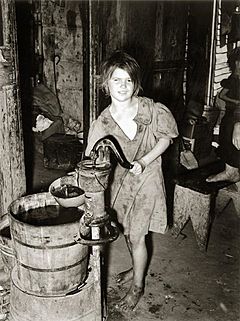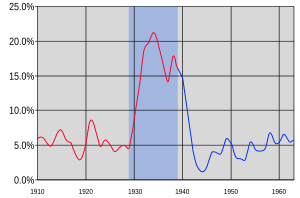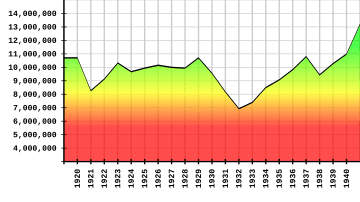Recession of 1937–1938 facts for kids
The recession of 1937–1938 was a difficult economic period in the United States. It happened during the Great Depression in the United States, which was a time of very low economic activity.
By the spring of 1937, the economy seemed to be getting better. Factories were producing more, businesses were making money, and people's wages were back to what they were in 1929. Even though many people were still out of work, the number was much lower than the 25% unemployment rate seen in 1933.
However, in the middle of 1937, the American economy suddenly got worse again. This downturn lasted for about 13 months, through most of 1938. Factory production dropped by almost 30 percent. Making "durable goods" (things that last a long time, like cars and appliances) fell even faster.
Unemployment, which means people looking for jobs but not finding them, went up sharply. It jumped from 14.3% in May 1937 to 19.0% by June 1938. This meant fewer people had jobs. When people had less money, they spent less. This led to even more cuts in production by businesses.
Contents
Why Did the 1937 Recession Happen?
During this time, President Franklin D. Roosevelt was in his second term. Many people wondered why the economy took another dip. Some thought it was just a normal part of how economies work, like a "business cycle." But Roosevelt had taken credit for the good economic times before 1937. So, when things got bad again, he faced a lot of criticism.
Some people, especially those who supported businesses, blamed Roosevelt's "New Deal" policies. They said the government was being too hard on big companies. They also pointed to large strikes organized by labor unions like the CIO (Congress of Industrial Organizations) and the AFL (American Federation of Labor). These groups argued that the economy only got better after 1938 because these threats to businesses became less severe.
For example, government efforts to break up large companies (called antitrust efforts) didn't lead to many big cases. Also, the CIO and AFL unions started fighting each other more than they fought companies. Tax rules also became more helpful for businesses to grow.

A poll in 1939 asked if people thought the Roosevelt administration's attitude toward business was slowing down recovery. More than twice as many Americans said "yes" than "no." Business owners felt even more strongly that way.
However, other experts, called Keynesian economists, had a different idea. They believed the recession happened because the government tried to cut back on spending too soon. President Roosevelt had been careful not to spend too much money, and in 1937, he even managed to balance the government's budget.
These economists argued that the government needed to spend more money, even if it meant borrowing (called "deficit spending"). They felt that by not spending enough, Roosevelt didn't fully use this tool to boost the economy.
Roosevelt's Response to the Downturn
In November 1937, President Roosevelt thought that big businesses might be trying to hurt his New Deal programs. He believed they were causing another depression on purpose so that voters would choose Republican leaders instead. He called this a "capital strike," meaning businesses were holding back their money and investments. He even asked the Federal Bureau of Investigation to look for a criminal plot, but they didn't find one.
Roosevelt then started speaking out strongly against "monopoly power," which he saw as the cause of the new crisis. His Secretary of the Interior, Harold L. Ickes, criticized powerful business leaders. Ickes warned that if these big businesses were not controlled, they could create a "big-business Fascist America—an enslaved America."
Roosevelt appointed Robert Jackson to lead the antitrust division of the Justice Department. This effort to control big businesses became less important once World War II started. At that point, the government urgently needed big businesses to produce war supplies.
But the administration had another important response to the 1937 downturn. Roosevelt listened to the Keynesian economists and others in his government. He reluctantly stopped trying to balance the budget. In the spring of 1938, he launched a huge spending program of $5 billion. This was meant to give people more money to spend.
In a fireside chat (a radio address to the nation), Roosevelt explained his plan. He told Americans that it was the government's job to "create an economic upturn" by giving more "purchasing power" to the nation.
Economic Recovery Begins
The American economy started to get better in mid-1938. However, the number of people employed didn't reach the levels seen in early 1937 until the United States entered World War II in late 1941.
By 1939, the total personal income in the country was almost back to 1919 levels. However, because the population had grown, the income per person was not as high. The number of people living on farms had dropped by 5%, but farm production was up by 19% in 1939.
Jobs in private factories returned to the levels of early 1929 and early 1937. But they didn't go higher until World War II began. Factories also became more efficient, meaning they could produce more goods. By 1942, the total amount of goods produced was much higher than in both 1929 and 1937.
See also
 In Spanish: Recesión de 1937-38 para niños
In Spanish: Recesión de 1937-38 para niños



